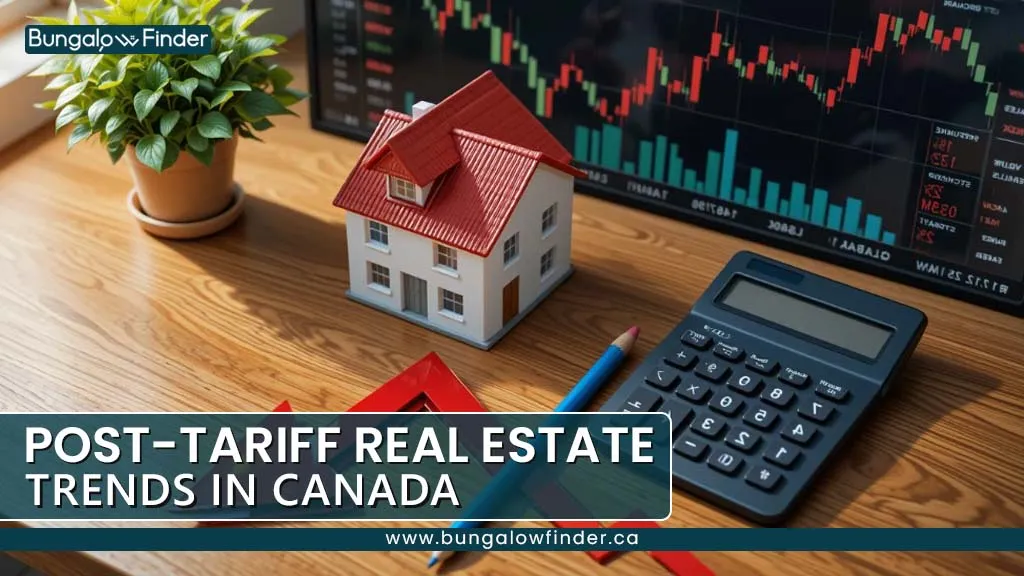How U.S. Tariffs Are Reshaping Canada's Housing Market in 2025
Discover how U.S.-Canada tariffs are quietly transforming real estate in Toronto, Vancouver, and beyond. Buyers, sellers, and builders must adapt fast.

What happens when rising tariffs change the basic structure of a country's housing market without anyone noticing? The Canadian real estate market is starting to feel the effects of the trade tensions between the U.S. and Canada, which began just four months ago. Regional markets are changing in ways that could have long-term effects as developers rethink project timelines and sellers deal with prices that change unexpectedly.
Take a closer look at how these new trends are developing and what they mean for homes for sale, sellers, and developers.
What Was It Like Before?
In February 2025, a wave of tariffs shook Canada’s trade environment: the U.S. slapped a 25% duty on most Canadian exports—with steel and aluminum tariffs at a steep 50%—and Canada responded in kind. Since then, these trade measures have been working their way into the bones of the Canadian Housing Market, particularly in the built environment and resale segments.
Rising Construction Costs: A Silver Lining with Hidden Fees
Tariffs don’t just hit news headlines—they funnel into real life through rising costs on the ground. Canadian builders have been feeling it most: the price of steel, aluminum, imported appliances, even lumber—once exempt but still vulnerable to repricing—has shot upward. The U.S. National Association of Home Builders (NAHB) estimates these duties tack on roughly $10,900 to the cost of a new home, while other sources place the figure between $9,200 and $11,000 CAD.
So, does Canada’s construction market confirm this? The answer is yes! In Western hubs like Calgary and Edmonton, labour and materials continue creeping upward. Even in the Toronto area, which is usually more stable, prices are still high. However, prices for trades like formwork have decreased a little because fewer new starts exist.
That means developers are in a tough spot: they can either raise prices for buyers, postpone or cut back on projects, or find other ways to cut costs. A growing number are doing the latter—stockpiling materials, switching to local suppliers, or changing the terms of contracts to move risk. This is a story happening all over North America.
Prices Cooling in Hot Markets, Steady Elsewhere
If you’re looking for homes for sale, the calm in resale markets is noticeable. CREA reports that national resale activity hit its lowest levels since 2009 for March and April, dropping about 20% from late 2024 peaks, and prices fell roughly 3.6% year‑over‑year by April.
In Ontario’s Greater Toronto Area, pricing has dipped more sharply—around 6.2% over five months—while smaller markets like London and Hamilton also slipped 6–7%. B.C.’s cooling isn't as extreme but still noticeable, with the composite index dropping nearly 2.8% in Vancouver and the Fraser Valley.
Buyer Behavior: From FOMO to Caution
In the thick of it, buyers have stepped back. Where spring is usually a flurry of activity, markets were strangely still this year. CREA economist Shaun Cathcart notes property listings are piling up—nearly five months’ worth of inventory as prices cooled.
Behind this shift is uncertainty. Tariffs aren’t just another economic variable; they’re unpredictable and—unlike mortgage rates—their path forward is unclear. Buyers are rightfully wary. Real estate agents report more negotiation, fewer bidding wars, and greater interest in move-in-ready properties. Investor activity? Nearly nonexistent for the moment.
Despite some rate cuts by the Bank of Canada, the combined weight of inflation, job market jitters, and trade concerns makes the mood cautious.
Builders Are Recalibrating
Developers are in a tough spot. Pre-construction projects—particularly in Toronto—are getting reevaluated: fewer launches, adjusted prices, tightened specs. Some are even postponing new launches until cost predictability returns.
Smaller firms and renovators share similar pain. Cost overruns, supply delays, and contract disputes—especially on who covers tariff-induced hikes—are common. Many are leaning heavily on flexible contracts, cost-plus pricing, or passing escalation clauses on to homeowners.
The combination of trickier financing, eroded margins, and unpredictable materials makes building anything riskier and slower.
Regional Stories: Winners and Laggards
What makes this period especially intriguing is its regional divergence.
Toronto & Vancouver: The heavyweight markets face the sharpest cooldown. Sellers are adjusting expectations, and buyers have leverage. Where last year you had to rush, this spring you could pause and think, then negotiate.
Alberta & Saskatchewan: Here, the heat’s off. Tariff exposure is lower, and these provinces are backed by robust commodity-based economies. Some are even seeing renewed interest from city-dwellers priced out of Toronto or Vancouver.
Quebec & Atlantic Canada: Surprisingly steady. Their markets weren’t overbuilt, and fewer goods flowed across borders, meaning less tariff impact. In communities from Montreal’s inner suburbs to smaller Atlantic towns, moderate price growth remains possible if confidence stays.
What It All Means for You
For homebuyers, this is likely the best window we’ve had in years: more inventory, fewer bidding wars, and room to negotiate. If affordability is key, now is the moment to act.
For sellers, sharpening your marketing and pricing strategy is crucial. Getting ahead of the tariff narrative—or leveraging provincial growth—can help you stand out.
For developers, navigation is tricky. Pre-con offers need flexible terms, local sourcing, and contingency planning. Provincial markets that are insulated from trade risk may offer a smarter ground for new projects.
For real estate professionals, being able to explain the full arc—tariffs, cost pressures, buyer psychology, and regional shifts—is essential. Clients want context, nuance, and a clear sense of whether now is “wise bold” or “cautious patience.”
Final Thoughts
Four months after the tariff storm rolled in, the Canadian housing landscape is in a quiet but real transition. It’s not a crash, but it’s no longer a boom. Tightening costs are filtering into construction. Resale markets are cooling. Buyers have regained influence.
With attention, adaptability, and the right timing, the next few quarters could be a period of strategic advantage for anyone engaged in the Canadian housing market.
FAQs
1. How have tariffs affected the Canadian real estate market?
Tariffs have increased material and import costs, which have raised construction expenses and slowed down new builds. This has led to cautious buyer behavior and softer pricing in major cities.
2. Are home prices dropping because of tariffs?
Yes—especially in Toronto and Vancouver, where prices have fallen by 5–6% since February 2025 due to reduced demand and rising costs.













